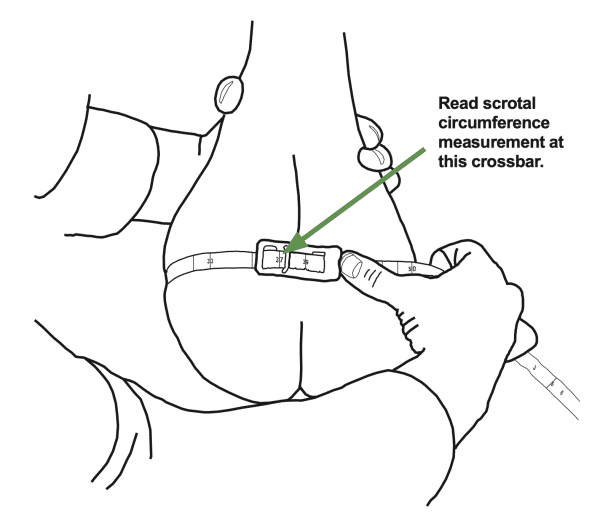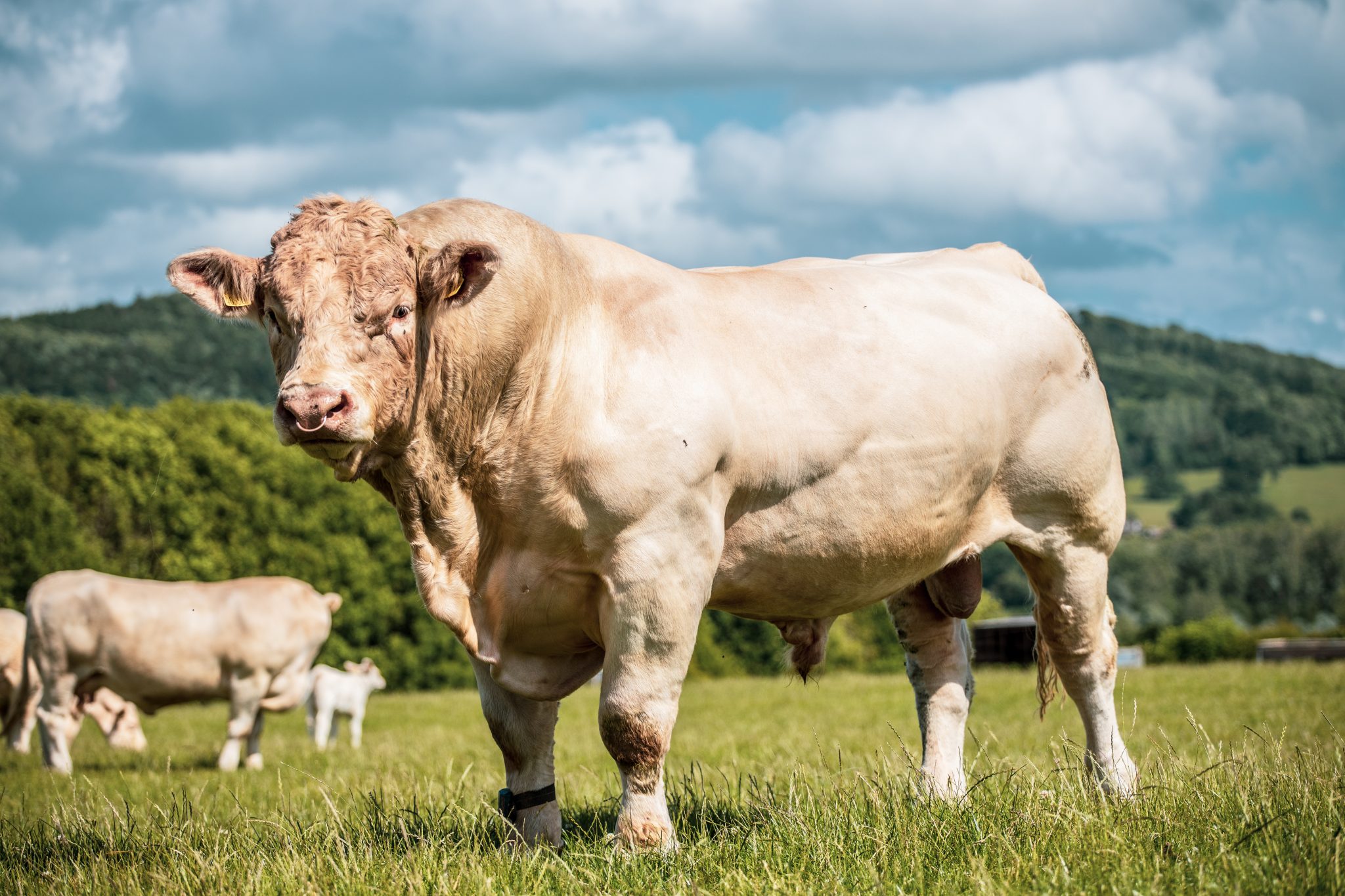Beef

Scrotal circumference is an important criterion for producers to consider when selecting and developing bulls with the highest possible reproductive capabilities.
Measuring scrotal circumference is an important evaluation tool to employ when developing bulls on- farm, at a centralized bull development facility, or before purchasing herd sires. It does not take the place of a complete bull breeding soundness examination (BSE) performed by a veterinarian. However, if you know that certain bulls don’t meet the minimal requirements for scrotal circumference, there is no need to buy, continue developing, or perform complete BSEs on those bulls. For more information on BSEs, see Bull Breeding Soundness Examinations (Extension publication ANR-1335).
Adhering to the following guidelines, anyone with adequate handling facilities and minimal additional equipment can effectively measure a bull’s scrotal circumference. This information can then be used to make informed management decisions.
Importance of Scrotal Circumference
Scrotal circumference is correlated to daily sperm production, which is directly related to a bull’s ability to impregnate an acceptable number of cows or heifers over the course of a breeding season. Heifers sired by bulls with a larger scrotal circumference tend to reach puberty earlier.
Most heifers are bred when they are 14 to 16 months old with the goal that they deliver their first calf when they are approximately 2 years old. On average, 50 percent of heifers reproductively cycle by 12 months of age, and the rest have their first cycle by 14 months.
The first estrus (heat) may be subfertile. Normal pregnancy rates typically do not occur until the third estrus cycle after puberty. For this reason, selection for early puberty is advantageous for optimal reproductive success in heifers.
A reliable way to select for early puberty in heifers is to use a herd sire with a large scrotal circumference. However, this attribute alone is not always a sufficient basis on which to make a good decision. Other characteristics also must be taken into consideration. Following is an example of two bulls, both of which should be culled:
Bull A has great scrotal circumference but poor conformation, inadequate growth, low calving ease expected progeny differences (EPD), high birth weight EPD, and light muscling. Making the decision to cull in this case is easy. Despite his great scrotal circumference (thus his very likely ability to sire future generations), his undesirable physical attributes make him a poor candidate as a herd sire.
Bull B has ideal conformation, high growth, high calving ease EPD, low birth weight EPD, and heavy muscling, but he has inadequate scrotal circumference. Culling this bull is a much more difficult decision to make given his highly desirable physical characteristics. But using Bull B with an inadequate scrotal circumference as a herd sire has potential long-term negative consequences given the likelihood that his heifer daughters will reach puberty later than desired and therefore be slower to breed. Developing strict criteria and adhering to them will pay dividends in the long run.
Effects of Puberty on Scrotal Circumference
Some breeds and some individual bulls mature more slowly and reach puberty at a later age. This is not necessarily a negative attribute; it’s just something that needs to be taken into consideration when evaluating scrotal circumference since puberty has a dramatic effect on scrotal circumference. For instance, if Bull B from our example does not meet your minimal scrotal circumference guidelines at 12 months of age, he may just need another month or two in order to catch up to his contemporaries. On the other hand, if he still is not meeting your minimal scrotal circumference guidelines by 18 months of age, he likely will never meet the requirements.
Scrotal Circumference Tape
A scrotal circumference tape is used to measure a bull’s scrotal circumference. It comes in two basic varieties: those that indicate when adequate pressure is being applied to the scrotum and those that don’t. Either variety is fine to use. The important thing is to find a scrotal circumference tape that you are comfortable using and gives you consistent results. Be sure to follow manufacturer instructions regarding how to properly read the scrotal measurement. Regardless of the type, scrotal circumference tapes are relatively inexpensive and should last for many years.
Measuring Scrotal Circumference
Consideration for human safety is critical for this procedure.
Bulls are big and strong and can be unpredictable at times. DO NOT attempt to measure a bull’s scrotal circumference without adequate handling facilities. Serious injury can occur without appropriate precautions.
Preparing to Measure
Safely restrain the bull in a squeeze chute and place a bar securely behind the bull so that he can’t back up in the chute. The scrotum can then be accessed from behind the bull (preferred in most situations) or by opening the bottom side panels on the chute.
If working from the side, first ensure that the bull is not likely to kick his back legs forward. Position yourself in a safe location and then slap his belly and quickly remove your hand.

Figure 1. Proper method for measuring scrotal circumference
If working from behind, be sure to work underneath the bar that is behind the bull. Working from above the bar risks your arms being caught between the bull and the bar. Have someone on the outside of the chute maintain positive control of the bar by holding onto the end of it. This minimizes the risk of the bar injuring the person measuring the scrotal circumference in the event that the bull moves quickly.
Regardless of whether you choose to perform the scrotal circumference measurement from the side or behind the bull, having someone ‘tail’ the bull will make the procedure much safer. To do this, have an assistant grasp the bull’s tail approximately 8 to 10 inches from the tail head and push the tail straight up. Pushing the tail to the side will have little to no effect, but pushing the tail straight up will greatly reduce the likelihood of the bull kicking.
Depending on the ambient environmental temperature and disposition of the bull, the testicles might be pulled up close to his body wall. In order for you to accurately measure scrotal circumference, the testicles must first be gently pushed all the way into the bottom of the scrotum. Hold the testicles in this position by placing your thumb and fingers on both sides of the scrotum above the testicles (figure 1). Do not place fingers between the testicles as this will inadvertently result in a larger and inaccurate scrotal circumference measurement.
Taking the Measurement
- Slip the loop formed by the scrotal tape over the scrotum around the widest point.
- Pull tape snugly until (1) there is a slight indent in the skin (if you are using scrotal tape that does not indicate when adequate pressure is being applied to the scrotum, as in figure 1, or (2) until adequate pressure is indicated by the scrotal tape itself.
- Take the circumference reading (in centimeters) at the index formed by the small stainless steel crossbar on the scrotal circumference tape thumb piece. For example, the bull in figure 1 has a scrotal circumference that is slightly greater than 37 centimeters.
- Repeat measurement procedure to confirm results.
Minimal Scrotal Circumference Measurements
The numbers listed in table 1 are the minimal scrotal circumference measurements based on age as set forth by the Society for Theriogenology. Keep in mind that these are minimums. Ideally, developing and adult bulls will exceed these measurements.
Table 1. Minimal Recommended Scrotal Circumference (SC)
Adapted from the Bull Breeding Soundness Evaluation form, Society for Theriogenology.
| Age | SC (cm) |
|---|---|
| Younger than 15 months | 30 |
| 15–18 months | 31 |
| 18–21 months | 32 |
| 21–24 months | 33 |
| Older than 24 months | 34 |
Download a PDF of Bull Scrotal Circumference, ANRF-2671.


